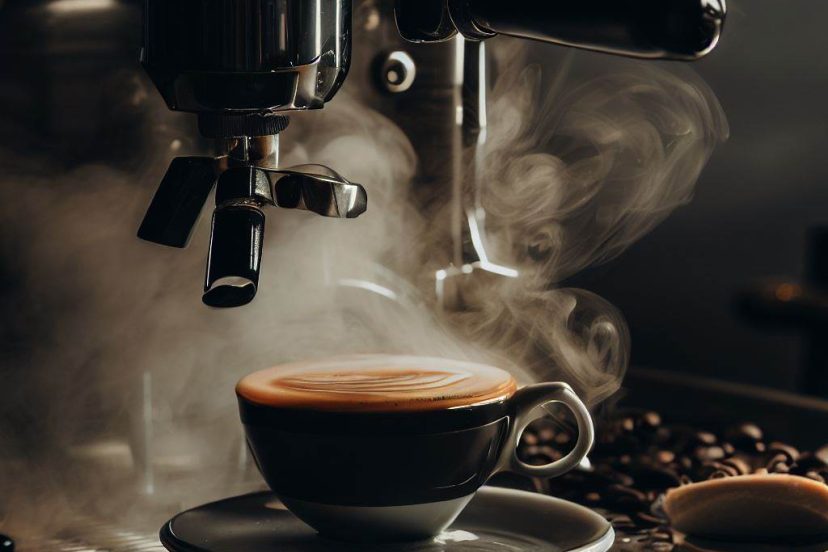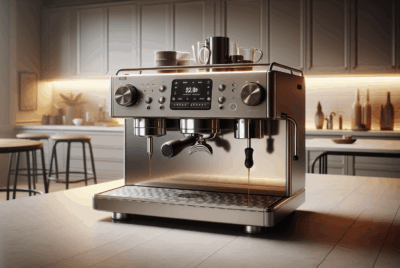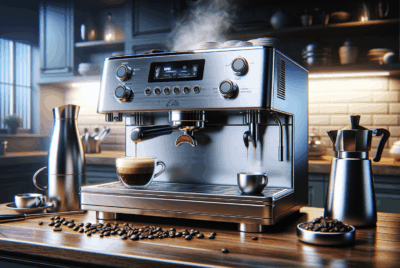Espresso Basics: From the Grounds Up
As an Amazon Associate, I earn from qualifying purchases, at no additional cost to you. Disclaimer
Introduction to Espresso Basics
The Origin of Espresso
Rewinding to the past, our journey to understand espresso basics lands us in Italy in the early 1900s. Italians sought a method to reduce the time it took workers to enjoy their coffee. Enter Luigi Bezzera, a clever man who found a way to pressure steam and brew coffee in a shorter time. Voilà! Espresso was born.
Imagine strolling down the cobbled streets of Rome, the air heavy with the tantalizing aroma of freshly brewed espresso from nearby cafés. Each café boasting their unique blends and brewing techniques. The passion and precision that goes into making each cup were palpable, reflecting espresso’s rich heritage.
Espresso Basics: The Espresso Machine
In essence, espresso machines are akin to a painter’s canvas – there are myriad possibilities of what can be created on it. They might seem intimidating at first, much like my own initial impression. But as you start exploring, they unfold like a fascinating puzzle.
Components of an Espresso Machine
The heart and soul of making espresso lie in the machine’s components. There’s a boiler to heat water, a group head that disperses the heated water, a portafilter that holds the coffee grounds, and a steam wand to froth milk for your cappuccinos and lattes. When I first started diving deep into researching coffee, I spent hours learning and understanding each component’s functionality. It reminded me of my childhood days, tirelessly working on intricate Lego models, each piece having its unique place and purpose.
Types of Espresso Machines
The world of espresso machines is as diverse as the people who use them. From the vintage manual lever machines to the state-of-the-art super-automatic ones, there is a machine for everyone.
Manual lever machines give you complete control over the brewing process, but they require skill and patience. On the other hand, semi-automatic, fully automatic, and super-automatic machines progressively offer more automated processes for convenience.
I recall my first espresso machine – a modest semi-automatic model. It was the perfect companion for a beginner like me, offering a balance between control and ease-of-use. Upgrading to a super-automatic machine felt like stepping into the future, a testament to how technology has influenced this beloved beverage.
As you dive into the world of espresso basics, take the time to understand what each type offers. It’s like purchasing your first car – explore your options, consider your needs and preferences, and make an informed choice.
Espresso Basics: Understanding Espresso
What Makes an Espresso
Espresso is a concentrated coffee beverage, and contrary to what some might believe, it’s not just strong coffee. Its creation involves pushing hot water under pressure through finely ground coffee beans. A golden elixir emerges carrying with it the soul of the coffee bean – all its complex flavors, essential oils, and caffeinated punch.
I can still recall the first time I watched an espresso shot being pulled. The barista was an artist, her canvas was the coffee, and the espresso machine her tool. As the deep, golden liquid flowed from the machine into the tiny cup, I was struck by the simple complexity of the process. In that small serving lay the promise of a robust and invigorating experience.
Espresso Vs. Coffee
Despite sharing a common source, espresso and coffee are different siblings of the same family. The differences lie in their brewing methods, taste, concentration, and presentation. Think of espresso as a book of short stories – intense, concentrated, each serving packing a punch. On the other hand, coffee is a lengthy novel, milder, and meant to be enjoyed over an extended period.
During my travels, I’ve found that one’s preference often depends on the pace of life. In Italy, busy folks grabbing a quick shot of espresso at a stand-up bar before rushing off to work is a common sight. Meanwhile, in cities like Vienna or Paris, you might find people leisurely sipping their café crèmes and americanos in sidewalk cafes.
Remember, there’s no right or wrong preference. Some days you might crave the quick, flavorful boost of an espresso shot, and other days you might prefer to savor a soothing cup of brewed coffee. I always advise fellow coffee lovers to try different beverages and find their unique preferences. In the grand scheme of things, variety only adds to the joy of the coffee experience.
Espresso Basics: Making the Perfect Espresso
Making espresso at home can feel a bit like performing magic. You’re transforming simple, raw ingredients into something exquisite. It’s a journey of learning, experimenting, and, most importantly, savoring.
The Beans
Choosing the Right Beans
The hunt for the perfect espresso starts with the beans. For espresso, a blend of beans is often used to achieve a harmonious balance of flavors. Darker roasts are typically favored for their robust flavor and lower acidity, but it ultimately boils down to personal preference.
I remember when I first started my own home-brewing, exploring a range of beans was like globe-trotting from my kitchen. From the fruity undertones of Ethiopian beans to the chocolatey depth of Colombian varieties, each offered a unique tasting experience. So, don’t hesitate to experiment. Find what tickles your palate and lifts your spirit!
Grinding the Beans
Grinding the beans correctly is as crucial as having high-quality beans. Espresso requires a fine grind, but not as powdery as powdered sugar. The goal is a consistency similar to table salt. It may seem minute, but this detail can make the difference between an average and an amazing shot of espresso.
When using my first coffee grinder, I spent weeks tweaking and experimenting to find the optimal grind size. It was a period of trial and error, filled with the anticipation that comes with a new learning experience. The reward was an espresso shot that struck the perfect balance between bitterness and acidity.
The Brewing Process
Tamping
After grinding comes tamping – the process of packing your coffee grounds into the portafilter. How firmly should you tamp? Too loose, and water will rush through the coffee, leading to under-extraction. Too tight, and the water will struggle to get through, leading to over-extraction.
My initial tamping was a comedy of errors, with wildly varying results from one shot to the next. But practice makes perfect. It’s like learning to play a musical instrument, at first, it feels awkward and alien, but with time, it becomes second nature.
Extraction
Extraction is the climactic act of the espresso making process. It’s where the magic happens. Hot water under high pressure is forced through the compacted coffee, resulting in a concentrated, complex shot of espresso.
This stage never ceases to thrill me. It’s like watching a suspenseful movie scene – the anticipation builds as the first few drips appear, then the flow steadies into a stream of liquid gold, indicating that your delightful shot of espresso is ready to savor.
Espresso Drinks
Once you have your espresso, the world of coffee-based drinks unfolds before you. From the robust Americano to the creamy latte, each drink is a delightful variation on the espresso theme.
Americano
An Americano is a simple yet profound drink that’s made by diluting a shot of espresso with hot water. The result is a coffee that has the strength of a drip brew but retains the nuanced flavors of espresso. On days when I crave the richness of espresso but desire a longer, more leisurely drink, an Americano is my go-to choice. It’s like enjoying an abridged version of your favorite book.
Cappuccino
A cappuccino is a harmonious blend of equal parts espresso, steamed milk, and milk foam. It’s a dreamy drink that can be sipped slowly, the creamy milk tempering the robust espresso while the foam adds a light, airy finish. I still remember my first successful attempt at making a cappuccino. The pleasure of crafting that perfect balance of coffee and milk was akin to finding harmony in a beautiful piece of music.
Latte
A latte is a more milk-heavy cousin of the cappuccino, composed of espresso with steamed milk and a small layer of foam on top. It’s perfect for those who prefer a milder coffee flavor in their drinks. Crafting a perfect latte is like a comforting routine. The process of gently pouring warm milk into the rich, dark espresso, creating that tiny layer of foam on top – it’s a beautiful, soothing ritual that never fails to bring a sense of calm to my day.
Mocha
A mocha is the delightful union of coffee and chocolate, featuring espresso, chocolate syrup, and steamed milk. Topped off with a dollop of whipped cream, it’s a decadent treat perfect for when you need a little extra indulgence. I often compare making a mocha to a bit of culinary alchemy. Combining the intense flavors of espresso and chocolate creates a drink that is both comforting and exciting, a treat that is as much dessert as it is a beverage.
Espresso Martini
The Espresso Martini is an exciting cocktail made from espresso, vodka, coffee liqueur, and sugar syrup. It’s a classy, after-dinner drink that marries the energy-boosting properties of coffee with the relaxing effects of a cocktail. Making an Espresso Martini is like hosting a small, personal celebration. The clink of the shaker, the satisfying pour into the glass, and the final sip – it’s a ritual that adds a touch of glamour and excitement to any day.
Each espresso-based drink is a testament to the versatility of espresso. Try them all, play with proportions, and most importantly, have fun exploring these delightful concoctions.
Maintenance and Cleaning
Just like a car needs regular servicing to run smoothly, your espresso machine needs consistent maintenance and cleaning to produce the best coffee. That’s why I’m including it as part of our espresso basics. Proper maintenance not only ensures great tasting espresso but also extends the machine’s life.
Daily Cleaning
Daily cleaning should involve purging the machine after every use. It involves running water through the group head and steam wand to clear out any coffee or milk residues. I like to think of it as giving your espresso machine a quick rinse after a good workout. Trust me, your machine will thank you by producing consistently tasty espresso shots.
Also, don’t forget to clean the drip tray and empty out used coffee grounds from the portafilter after each session. My tip: Use the spent grounds in your garden as compost, your plants will love it!
Weekly Cleaning
Every week, give your machine a more thorough cleaning. This involves backflushing the group head with a cleaning solution designed for espresso machines. The process removes the build-up of coffee oils and grounds that can affect the taste of your espresso. It’s a bit like giving your machine a mini spa treatment.
Additionally, remember to scrub the portafilter and basket. Soak them in a cleaning solution and scrub away any stubborn residues.
Monthly Maintenance
Monthly maintenance should involve descaling your machine. Over time, minerals from the water can build up inside your machine and impair its performance. Descaling removes these deposits and ensures your machine continues to function optimally.
When I first started using an espresso machine, I underestimated the need for descaling until I noticed an unusual change in the taste of my espresso and the performance of the machine. A thorough descaling brought everything back to normal, a testament to its importance.
Professional Servicing
Finally, consider getting your espresso machine serviced by a professional once a year. They will check the overall health of your machine, replace worn-out parts, and ensure everything is in top condition. It’s like going for an annual health check-up but for your espresso machine.
Maintaining your espresso machine might seem like a lot of work, but it’s a labor of love. The reward is delicious, consistent espresso and a machine that will serve you well for many years to come.
Conclusion
Espresso brewing is an art that combines science, skill, and passion. Whether you’re a seasoned coffee lover, wannabe Barista, or a curious beginner, mastering the basics of espresso can elevate your coffee experience. So, why not dive into the world of espresso and explore the myriad of flavors it offers?
Frequently Asked Questions (FAQs)
1. What is the ideal pressure for brewing espresso?
The ideal brewing pressure is usually around 9 to 10 bars.
2. Can I use regular coffee beans for espresso?
Yes, you can. However, espresso beans are typically darker, oilier, and roasted to a higher degree.
3. How long should an espresso shot take?
A typical shot of espresso should take between 20 to 30 seconds.
4. What is the ideal water temperature for espresso?
The perfect water temperature is around 195-205 degrees Fahrenheit.
5. Is espresso stronger than coffee?
Yes, espresso has a stronger taste and more caffeine per volume than regular coffee. However, because the serving size is smaller, a cup of coffee often has more total caffeine.




